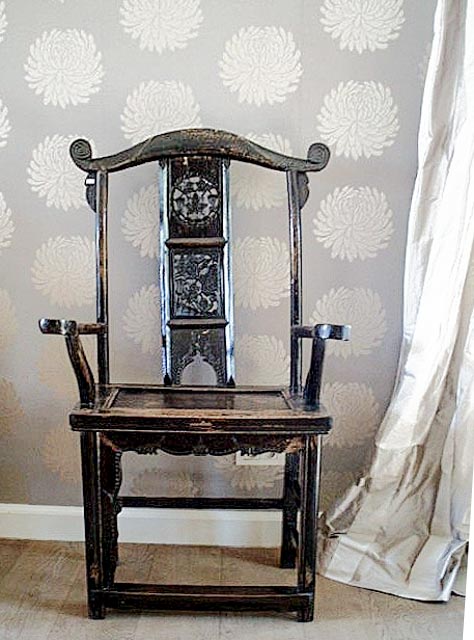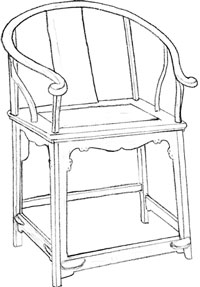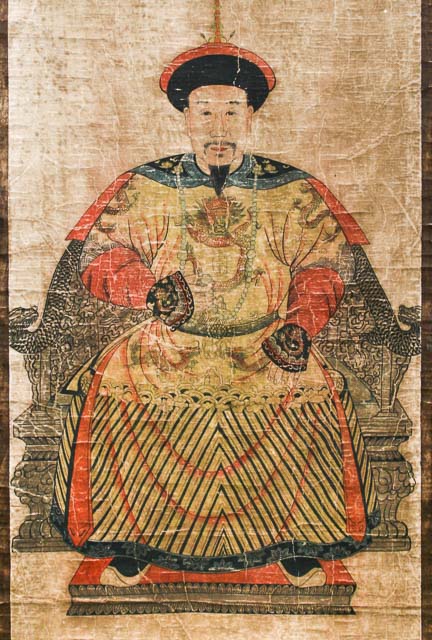Furniture designed for sitting has a pretty recent history for a country as ancient as China. Before the introduction of chairs, Chinese people sat on the floor or sitting mats. An elevated seat, usually single, only existed as status symbols, e.g. thrones.
The earliest indications of chairs came with Christian missionaries and Buddhist monks who travelled along the Silk Road 1400 years ago. However, it still took five hundred years for the chair to become widespread in all of China (well, it is a big country).
Typical Chinese chairs

What makes Chinese furniture stand out from their European and American equivalents is that in China furniture was made of interconnected wood with woodworking joints instead of nails. Weather and temperature conditions did not permit the use of glue or iron nails. For a long time chairs were an important status symbol in China and were used by the most senior people in the family and offered to important guests when they were invited in the home.
These beautiful Chinese chairs were, of course, made for the elite. Normal people such as farmers, workmen and shopkeepers had to do with simple, wooden stools and benches.
Two types of Chinese chairs that fit remarkably well in contemporary styled interiors are the Yoke-back chair and the Horse-shoe chair.
The Yoke-back chair has been around for a thousand years, but has seen its most popular period during the last two Chinese dynasties: the Ming (1368-1644) and early Qing (1644-1911). The Yoke back chairs were so called mostly in the West because of the resemblance of its top rail with a yoke for oxen. The plain simplicity of this style was especially popular among the elites of the late Ming era and became an integral part of the Ming aesthetic. Chairs typically had a solid back, making the wide center splat (vertical back support) of the yoke back a real innovation to chair designs. Its original purpose was for function and comfort, but often it is delicately carved or inlaid, making it a visual attribute as well. A pair of Chinese yoke back chairs sent as a gift to King Phillip II in the 16th century must have inspired chair designs of the Western world, for around a century later these wide back splats and elegant proportions appeared (among others) in the Queen Anne (or Georgian) style chairs in England and America.

The Horse-shoe chair or round-back armchair is actually an evolved version of a curved armrest that was used when sitting on the ground. Its popular Western name describes the resemblance of the form of the armrest with a horse shoe.
During the Ming dynasty it developed into one of the most graceful chair forms of traditional furniture. Its round back exhibits the Chinese artistic aesthetic called ‘roundness’ or ‘wholeness’.
Combined with the square shaped base the chair is also a representation of the Chinese cosmological concept of ‘round heaven and square earth’. In Confucian thoughts a ‘square earth’ refers to moral integrity, while ‘round heaven’ symbolises the dome of heaven covering the earth as well as the constantly moving sun and moon. Stability and activity are also symbolised by yin and yang.
The rounded backrest and downward sloping armrest of the horse-shoe chair makes it an exceptionally comfortable support for the elbows and arms, to the surprise of many people unfamiliar with these chairs!
Traditional Chinese chairs, including the yoke back and horseshoe forms, often have a stretcher that supports the legs. These stretchers make its user step up and sit higher than the other, being an association with status and referring to a certain degree of authority or power. The Chinese term for this is “bubugao”, which means “step higher”, and was a commonly used symbolism in Western cultures as well. And as a further testament to the Chinese love of symmetry, most of these chairs came in sets of two.

The Silk Road Collection has a variety of pairs of Yoke-back chairs and Horse-shoe chairs. We have cleaned and restored the chairs where necessary, but essentially, we kept the look of the chairs as they are now. Often well-used and cared for over time, they symbolise a small part of Chinese culture and history.
The Silk Road Collection nurtures all decorations and furniture that is authentic by acknowledging three simple realities: nothing lasts, nothing is finished, and nothing is perfect. Our chairs and stools, including these well known yoke back and horse shoe chairs, can be used in classic as well as modern interiors. With the right combination of different styles, one can create an individual space that adds to one’s personality.